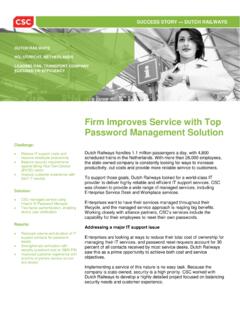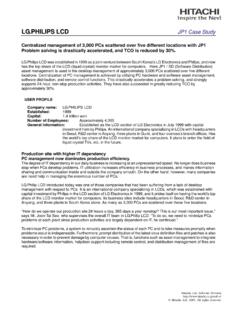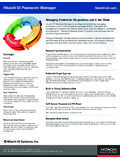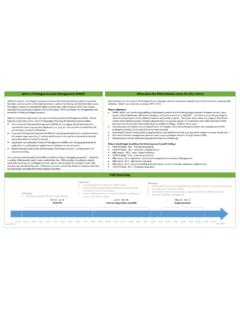Transcription of Magic Quadrant for User Provisioning - NetIQ
1 Magic Quadrant for user ProvisioningGartner RAS Core Research Note G00171056, Perry Carpenter, Earl Perkins, 6 September 2009, RA4 10152010 user Provisioning delivers the ability to manage identities across systems, applications and resources. Economic conditions stress efficiency as the main driver, but compliance remains crucial. Identity and access management intelligence and role life cycle management are increasingly top of mind. WHAT YOU NEED TO KNOWUser- Provisioning solutions are maturing in function and Provisioning market continues to consolidate, and boundaries between identity and access management (IAM) companion products are Provisioning functionality ( , workflow engines, approval processes, password management and standard connector sets) is similar across most vendors seek to find relevant means of differentiating their product sets from competitors through features such as: Role life cycle management More and better workflow options to enable business process management (BPM) and general governance, risk and compliance (GRC) needs Improved IAM intelligence ( , audit, analytics, monitoring, reporting) Better integration with security information and event management (SIEM), data loss prevention (DLP), and IT GRC management (GRCM) toolsLarge-scale user - Provisioning projects remain complex initiatives, and require experienced integrators and skilled project management on the part of the enterprise.
2 With relative functional parity evident in the software, most Provisioning implementations succeed or fail based on these integrators, and on the relationship between customers and rates for complex and/or major user - Provisioning initiatives are improving, but still plagued by first-generation horror stories and poorly integrated should consider key differentiators when selecting user - Provisioning solutions that include, but are not limited to:2 Price, including flexibility of pricing for deployment, maintenance and support programs Global scope, depth, availability, and extent of partnerships with consultants and system integrators to deliver the solution Consulting and integrator performance, which remains vital to success Delivery time of projects that match the business plan The ability to deliver subsidiary services that are not available in the core product through: Integrating component IAM features ( , common user experience, reporting) Custom development Augmentation via partnerships or adjacent products or capabilities (for example, role life cycle management, entitlement management, federated Provisioning or IAM intelligence) The level and extent of experience of customer-industry-segment vendors and integrators to deliver successful projects Other customer experiences, including satisfaction with installed Provisioning systems (that is, reference accounts)There is no one size fits all Provisioning solution; as such, these differentiators will vary in importance, given the specific organization, use case(s), budget and business driver(s).
3 Organizations must know which issues they are trying to address by deploying user Provisioning . Key concerns for customers include: A lack of clarity and priority in the issues to be resolved Project scoping Selecting the correct technology Rigorous project oversight Changing business goals during projects ( , trying to hit a moving target )Addressing these concerns early can help companies avoid a quagmire life cycle management is often a prerequisite (or, in more complex initiatives, a parallel effort) for many new user - Provisioning The Magic Quadrant is copyrighted September 2009 by Gartner, Inc. and is reused with permission. The Magic Quadrant is a graphical representation of a marketplace at and for a specific time period. It depicts Gartner s analysis of how certain vendors measure against criteria for that marketplace, as defined by Gartner. Gartner does not endorse any vendor, product or service depicted in the Magic Quadrant , and does not advise technology users to select only those vendors placed in the Leaders Quadrant .
4 The Magic Quadrant is intended solely as a research tool, and is not meant to be a specific guide to action. Gartner disclaims all warranties, express or implied, with respect to this research, including any warranties of merchantability or fitness for a particular purpose. 2009 Gartner, Inc. and/or its Affiliates. All Rights Reserved. Reproduction and distribution of this publication in any form without prior written permission is forbidden. The information contained herein has been obtained from sources believed to be reliable. Gartner disclaims all warranties as to the accuracy, completeness or adequacy of such information. Although Gartner s research may discuss legal issues related to the information technology business, Gartner does not provide legal advice or services and its research should not be construed or used as such. Gartner shall have no liability for errors, omissions or inadequacies in the information contained herein or for interpretations thereof.
5 The opinions expressed herein are subject to change without leaders niche players visionaries completeness of vision ability to execute As of September 2009 Oracle IBM Tivoli Novell Sun Microsystems CA Courion Sentillion Volcker Informatik Fischer International Quest Software llex Evidian (A Bull Group Company) Omada Microsoft Avatier Beta Systems BMC Software Siemens hitachi ID Systems SAP Figure 1. Magic Quadrant for user ProvisioningSource: Gartner (September 2009)3initiatives, and should be considered (at a minimum) as a concurrent requirement during the evaluation process. Many enterprises that have deployed user - Provisioning systems have discovered that an entitlement assignment capability (like role life cycle management) is a missing element. Customers should verify that the user - Provisioning provider has an inherent role life cycle management capability, has a role life cycle management partner or can articulate a comprehensive role life cycle management strategy relative to its offerings.
6 This ability will enhance user - Provisioning integration to areas such as IAM intelligence, GRCM and entitlement that planning for virtualization in the enterprise includes user Provisioning , since it plays an important role for virtual machines (VMs) by providing account Provisioning and auditing for partitions, hypervisors, and VM monitors, as well as enforcing segregation of duties (SOD) for that QUADRANTM arket OverviewIAM is a set of processes and technologies to manage across multiple systems: Users identities each comprising an identifier and a set of attributes Users access interactions with information and other assetsUser Provisioning is a key identity administration technology. user - Provisioning tools have some or most of the following functions: Workflow and approval processes Password management (with the ability to support self-service) Other credential management Role life cycle management user access administration (with the ability to support self-service) Resource access administration (with the ability to support self-service) Basic IAM intelligence (analytics, auditing, reporting), including SOD supportUser Provisioning is part of an overall IAM technology offering.
7 The four major categories of IAM are: Intelligence: This combines SIEM, SOD control and other monitoring tools to perform comprehensive activity, event and incident monitoring, reporting, and analytics for auditing and research purposes. Administration: This is where user Provisioning exists along with role life cycle management and other administrative tools to provide the basic administration capabilities for handling identities and entitlements, including resource access administration. It is also focused on providing the necessary service management capabilities to administer and manage identities effectively, from workflow to delegation, and from self-service to connector management. Authentication: This focuses on identity-proofing (that is, verifying users civil identities), as well as authentication methods and infrastructure, various single sign-on (SSO) technologies, identity federation and personal identity frameworks. Authorization: Focuses on authorization or entitlement management, and delivers Web access management, operating system access management and content access management, as well as network access control capabilities.
8 Access management is also involved in encryption, digital rights management and categories are based on a foundation of identity repository technologies that include enterprise Lightweight Directory Access Protocol (LDAP) directories, virtual directories, metadirectories, and (increasingly) relational databases. While standard LDAP directories remain the identity repository of choice, limitations inherent in these directories relative to fine-grained authorization and policy implementation may require database participation. LDAP directories are optimized for fast reads and are optimal for large environments, but there are limits, because in these large-scale environments ( , more than 500,000 users), there are significant changes requiring replication or writes. Traditional LDAP directories can experience performance problems during synchronization events, resulting in stale or unreliable solutions are the main engine of identity administration activities.
9 Gartner ranks vendors in the Magic Quadrant based partly on product capability, market performance, customer experience and overall vision to determine which vendors are likely to: Dominate sales and influence technology directions during the next one to two years. Be visible among clients through several marketing and sales channels. Generate the greatest number of information requests and contract reviews. Account for the newest and most-updated installations. Be the visionaries and standards bearers for the Market Trends An interesting pattern is emerging in the 2009 Magic Quadrant . Notice that vendor ratings are clustering into three main sections clear leaders have separated themselves from other competitors. The remaining vendors are clustered within the Challengers and Niche Players quadrants. Gartner believes that market forces will eventually pull these vendors to the center of the Magic Quadrant .
10 One other fairly distinct group, the Visionaries, appears to be unaffected by the gravitational force. Visionary companies are less focused on mass-market drivers; instead, they focus on resolving very specific IAM-related issues, and on creating products that address those issues. Several vendors are now offering more commercial off-the-shelf-like solutions to help small and midsize businesses (SMBs), or those afraid of long, custom implementations. Vendors are increasingly offering fixed price implementations. Most vendors made progress in user - Provisioning execution, showing improvements in features and functionality, marketing and sales execution, and customer base expansion. Many vendors also showed improvements in completeness of vision and customer experience because they focused more on their role management capabilities, reporting functionality and user interfaces. Concerns remain in large-scale implementations regarding areas such as workflow and connector management, and project duration.













